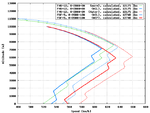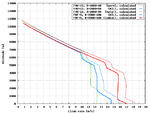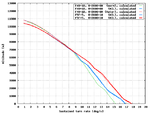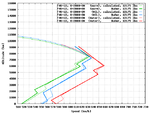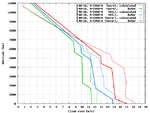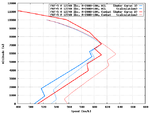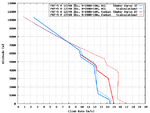Hi everyone,
Based mainly on the BuAer data sheets for the Vought F4U-1D Corsair and the Grumman F6F-5 Hellcat, I have prepared a performance comparison of these two types.
Though the BuAer data sheets provide a lot of data, it's partially self-contradictory, generic, or possibly wrong, so it required quite some effort and cross-checking with other data sources to distill the following comparison from it.
Note that within my analysis the F4U-1D and F6F-5 are considered to have essentially the same engine, with the only (irrelevant) difference between (respectively) their R-2800-8 and R-2800-10 being that the former is fitted with an updraught carburettor and the latter with a downdraft one. (If referred to as R-2800-8W and R-2800-10W, these are the same engines - I'm not sure if the "W" is even an official designation.) The ratings are taken from the BuAer F4U-1D data sheet, the F6F-5 BuAer data sheet actually differs slightly though both engines are in fact as good as identical. (Thanks to Pasoleati for pointing this out!)
The War Emergency Power, Water or Combat power is considered to be achieved at 60" Hg boost pressure in all three supercharger configurations (high speed, low speed, engine stage only). The BuAer F4U-1D data does not provide boost pressure figures, but Military and Normal power probably don't have uniform boost pressures over all three supercharger configurations. I'll leave the question of the absolute values open.
Combat and Military power are achieved at 2700 rpm, Normal power is achieved at 2550 rpm.
One difference resulting from the engine installation is that the F4U-1D has the benefit of ram effect even in the "neutral" gear when the auxiliary supercharger stage is skipped, while the F6F-5 draws air from the engine compartment and thus loses the ram effect. (I haven't been able to confirm that the F4U-1D really works like that from technical descriptions or diagrams, but an article on the two types by Grumman test pilot Corky Meyer pointed this out, so I went with it. Any extra data you might have would be welcome.)
One area where I have no data on is the exact amount of exhaust thrust in both aircraft. The good fit of my calculated F4U-1D data with the BuAer data shows that I'm probably very close to the real figures, but the fit with the BuAer F6F-5 data is not so good, and this might indicate that the exhaust system of the F6F-5 generates more direct thrust (though I doubt it, as F6F-5 speed data from different sources is generally mismatched to begin with). Thus I assumed the engines to be so similar that they gave the same amount of exhaust thrust for both types.
Regards,
Henning (HoHun)
Based mainly on the BuAer data sheets for the Vought F4U-1D Corsair and the Grumman F6F-5 Hellcat, I have prepared a performance comparison of these two types.
Though the BuAer data sheets provide a lot of data, it's partially self-contradictory, generic, or possibly wrong, so it required quite some effort and cross-checking with other data sources to distill the following comparison from it.
Note that within my analysis the F4U-1D and F6F-5 are considered to have essentially the same engine, with the only (irrelevant) difference between (respectively) their R-2800-8 and R-2800-10 being that the former is fitted with an updraught carburettor and the latter with a downdraft one. (If referred to as R-2800-8W and R-2800-10W, these are the same engines - I'm not sure if the "W" is even an official designation.) The ratings are taken from the BuAer F4U-1D data sheet, the F6F-5 BuAer data sheet actually differs slightly though both engines are in fact as good as identical. (Thanks to Pasoleati for pointing this out!)
The War Emergency Power, Water or Combat power is considered to be achieved at 60" Hg boost pressure in all three supercharger configurations (high speed, low speed, engine stage only). The BuAer F4U-1D data does not provide boost pressure figures, but Military and Normal power probably don't have uniform boost pressures over all three supercharger configurations. I'll leave the question of the absolute values open.
Combat and Military power are achieved at 2700 rpm, Normal power is achieved at 2550 rpm.
One difference resulting from the engine installation is that the F4U-1D has the benefit of ram effect even in the "neutral" gear when the auxiliary supercharger stage is skipped, while the F6F-5 draws air from the engine compartment and thus loses the ram effect. (I haven't been able to confirm that the F4U-1D really works like that from technical descriptions or diagrams, but an article on the two types by Grumman test pilot Corky Meyer pointed this out, so I went with it. Any extra data you might have would be welcome.)
One area where I have no data on is the exact amount of exhaust thrust in both aircraft. The good fit of my calculated F4U-1D data with the BuAer data shows that I'm probably very close to the real figures, but the fit with the BuAer F6F-5 data is not so good, and this might indicate that the exhaust system of the F6F-5 generates more direct thrust (though I doubt it, as F6F-5 speed data from different sources is generally mismatched to begin with). Thus I assumed the engines to be so similar that they gave the same amount of exhaust thrust for both types.
Regards,
Henning (HoHun)

